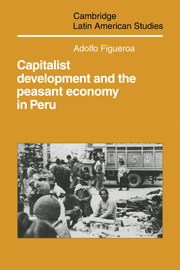Book contents
- Frontmatter
- Contents
- List of tables and figures
- Acknowledgments
- 1 Introduction
- 2 Scope and method
- 3 The economic unit and economic organization
- 4 Production and exchange
- 5 The level and structure of peasant income
- 6 The economic behavior of the peasant family
- 7 Stagnation in the peasant economy and the role of demand
- 8 Economic crisis and the peasant economy, 1975–1980
- 9 Conclusions: reality, theory and policy
- Appendixes
- Notes
- Bibliograph
- Index
- CAMBRIDGE LATIN AMERICAN STUDIES
8 - Economic crisis and the peasant economy, 1975–1980
Published online by Cambridge University Press: 04 August 2010
- Frontmatter
- Contents
- List of tables and figures
- Acknowledgments
- 1 Introduction
- 2 Scope and method
- 3 The economic unit and economic organization
- 4 Production and exchange
- 5 The level and structure of peasant income
- 6 The economic behavior of the peasant family
- 7 Stagnation in the peasant economy and the role of demand
- 8 Economic crisis and the peasant economy, 1975–1980
- 9 Conclusions: reality, theory and policy
- Appendixes
- Notes
- Bibliograph
- Index
- CAMBRIDGE LATIN AMERICAN STUDIES
Summary
The second half of the 1970s has been a period of economic crisis in Peru. The real GNP per capita of 1980 is almost 10% less than that of 1974. The annual rate of inflation has varied between 24% and 70%. Neither the decrease in real average income, nor the rates of inflation, nor the duration of the crisis has any parallel in the recent economic history of Peru. Since 1950 two short periods of crisis are recorded (1957–9 and 1967–9) but they were very mild compared to the present period. This chapter attempts to investigate the effect of the crisis on the peasant economy. To what extent has this economy been affected?
The extent of the crisis
In the post-World War II period until the mid-1970s Peru experienced sustained economic growth together with price stability. The real income per capita in 1974 was twice as high as in the 1950s. Annual rates of inflation never exceeded 18%. Starting around 1974–5 the economic situation changed dramatically: the economy stagnated until 1976, and there was an absolute decline in average real income. Real GNP per capita dropped by 8% in four years and the level of real income in 1980 was barely above that already reached back in 1971. The average annual rates of inflation went from 24% in 1975 to 68% in 1979. (See Table 8.1.) Politically, a new military government came to power in mid-1975, headed by General Francisco Morales Bermudez.
The origin of the crisis is commonly associated with excess demand in the economy, especially as a result of the government's overspending.
- Type
- Chapter
- Information
- Capitalist Development and the Peasant Economy in Peru , pp. 102 - 113Publisher: Cambridge University PressPrint publication year: 1984



